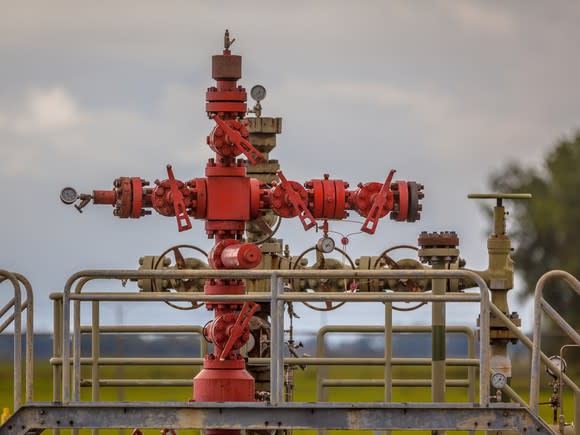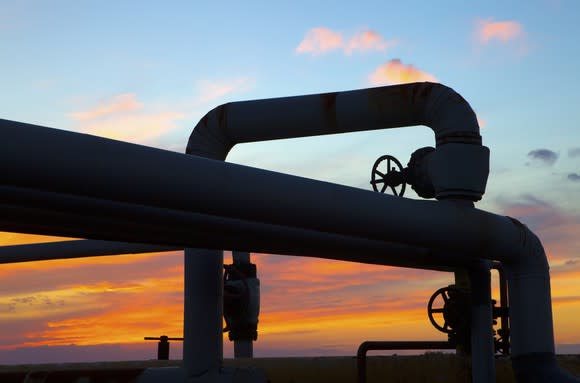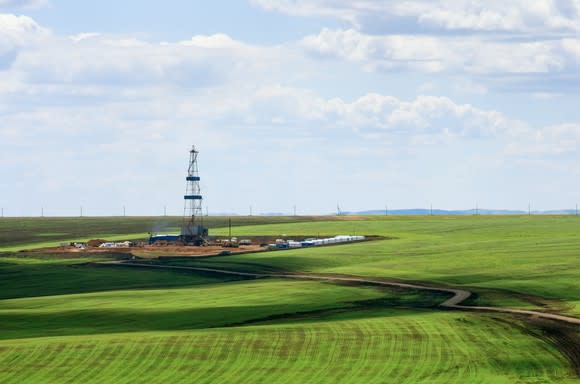An Investor's Guide to Natural Gas Stocks
Natural gas is a vital fuel, currently supplying 23% of the world's energy needs. It's poised to become an even more important energy source in the future, with the gas market projected to grow 40% by 2040 according to the International Energy Agency (IEA). One of the many factors that will drive this fast-paced demand growth is that natural gas produces fewer emissions than oil and coal, which makes it a cleaner choice in a world growing increasingly concerned with climate change.
With natural gas becoming an ever more important energy source, it's crucial that investors understand the industry. That way, they will be able to spot the best opportunities to profit from this fast-growing sector.

Image source: Getty Images.
What is natural gas?
Natural gas is a hydrocarbon that mainly consists of methane. The most common source of natural gas is underground rock formations, including in large cracks between rock formations, tiny pores within some formations like shale and sandstone as well as in coal deposits known as coalbed methane. Natural gas deposits often contain other gases in association with the methane, including carbon dioxide, neon, oxygen, and nitrogen as well as liquids such as oil, water, and natural gas liquids (NGLs) like ethane, propane, and butane.
In addition to underground sources, landfills, farms, and wastewater treatment plants also produce methane. This biomethane, also known as renewable natural gas, can be captured at the source, where it is then processed and purified so that it can enter the pipeline system just like gas produced from underground wells. Aside from heating homes and generating electricity, renewable natural gas is also used as a transportation fuel. For example, Clean Energy Fuels, which develops natural gas refueling stations, sells a branded renewable natural gas called Redeem to fuel commercial vehicles.
Natural gas drilling 101
Oil and gas companies drill thousands of wells each year. While many of them target oil, natural gas often comes up along with this crude, which is called associated natural gas. If there's adequate infrastructure in place, this gas flows through a midstream network, -- which is an integrated system of pipelines, processing plants, and related infrastructure -- to end users. However, if the necessary pipelines aren't in place, the associated gas is either flared (burned off at the wellhead) or reinjected back into the ground to help produce more oil because the gas isn't as valuable as crude.
Other wells, meanwhile, specifically target natural gas. That's usually because drillers can produce it at high rates and for low costs, making it economically viable. If drillers are targeting gas, they will ensure that the necessary infrastructure is in place to get the gas to market before completing wells so that they can maximize the value of the gas that they produce.
A brief history of fracking
Hydraulic fracturing, or fracking, is an important tool used to unlock oil and gas trapped in tight shale formations. While the technique has gained notoriety in recent years due to its importance in developing the Marcellus shale in Pennslyvania and West Virginia, it has been around since the late 1940s when Halliburton started experimenting with the process of pumping water and sand into wells under high pressures to fracture the rocks in a reservoir.
Fracking grew in importance in the 1990s when Mitchell Energy used it in combination with horizontal drilling, -- a process of drilling a well more than a thousand vertical feet before turning the drill bit 90 degrees and then continuing another thousand or more feet horizontally -- to tap Texas' Barnett Shale. Energy companies have refined both techniques over the years and transferred the technology to new shale regions, including those focused on oil like the Bakken Shale of North Dakota.

Image source: Getty Images.
The importance of pipelines
Because naturally occurring methane is in a gaseous state, it's not transported as easily as liquid fuels like oil. While liquids can move by truck, tanker, rail, or pipeline, natural gas can only flow through long-haul transmission pipelines to market centers unless it's turned into a liquid, which is a costly process. Because of that, natural gas producers need to have adequate access to pipelines and other midstream infrastructure to both move gas to market centers as well as maximize the value of their production.
When an energy company drills a new well, natural gas and other liquids will flow out. A specialized component at the wellhead then will separate the oil and water from this mixture. The oil will move down an oil-focused midstream network toward end users while the water is recycled or injected into a disposal well. The natural gas and NGL mixture will take a different path, flowing down a gas-focused midstream system.
From the wellhead, natural gas and a mixed stream of NGLs will flow into gathering pipelines that will transport them to a natural gas processing plant, which will separate the gas from the NGLs. The gas will then flow through the country's interstate pipeline system and into a localized distribution network where it can be used heat homes and business or generate electricity. The NGLs, meanwhile, head to a fractionation complex, which separates the mixed stream into its various components such as ethane, butane, and propane. From there, NGLs flow down pipelines to end users such as petrochemical complexes where they're transformed into the building blocks of plastics or put into tanks for your backyard grill.
The midstream sector is vital to the natural gas industry's growth. Based on current projections, North America needs to invest more than $400 billion into natural gas infrastructure in the coming years, including new gathering and transmission pipelines, processing plants, and LNG export terminals. This midstream expansion is an opportunity that natural gas investors won't want to overlook.
Liquefied natural gas (LNG) and how it's transported
In its natural state, methane is in gaseous form. However, natural gas can be a liquified at specialized LNG terminals. Companies first need to build liquefaction units, known as trains, which use refrigeration to cool the gas down to -260 degrees Fahrenheit, which is the point that it becomes a liquid and its volume shrinks by a factor of 600.
Once in a liquid form, the industry can then load the LNG into specialized gas carrying ships, LNG carriers, which keep LNG chilled while transporting it to global markets. Upon reaching its destination, the LNG goes through a regasification process by passing through heat exchangers that turn it back into a gas so that it can flow through the local pipeline system.
The largest natural gas producers in the U.S.
The U.S. is the world's largest gas-producing country, providing 20% of global supply in 2017. However, unlike some nations where one company produces most of the domestic gas supplies, several companies play a major role in the U.S. gas market. The table below displays the top ten natural gas producers in the United States:
Largest natural gas producers in the U.S. | Ticker symbol | Average daily production in 2018 |
|---|---|---|
EQT Corp. | (NYSE: EQT) | 3,666 MMcf/d |
ExxonMobil | (NYSE: XOM) | 2,583 MMcf/d |
Chesapeake Energy | (NYSE: CHK) | 2,387 MMcf/d |
Southwestern Energy | (NYSE: SWN) | 2,199 MMcf/d |
Cabot Oil & Gas | (NYSE: COG) | 1,862 MMcf/d |
BP | (NYSE: BP) | 1,767 MMcf/d |
Antero Resources | (NYSE: AR) | 1,691 MMcf/d |
Range Resources | (NYSE: RRC) | 1,497 MMcf/d |
CNX Resources | (NYSE: CNX) | 1,277 MMcf/d |
Gulfport Energy | (NASDAQ: GPOR) | 1,162 MMcf/d |
Data source: Natural Gas Supply Association. NOTE: Production through first six months of 2018. MMcf/d= million cubic feet per day.
This leaderboard has undergone many changes in recent years due to mergers and acquisitions, as well as a conscious decision by some producers to pivot away from natural gas to focus on oil. EQT Corp, for example, vaulted from fourth place in mid-2016 to first by late 2017 by drilling more wells and making a needle-moving acquisition. Meanwhile, other formerly large-scale gas producers have dropped off the top ten list due to asset sales and underinvestment in new wells, which caused their gas output to decline. That has opened the door for lesser-known names to climb the leaderboard.
Here's a closer look at three names on this list that natural gas investors will want to get to know.
EQT Corp: America's new natural gas king
EQT Corp surged from fourth place to the top of America's natural gas leaderboard last year after it acquired Rice Energy, which was the ninth largest gas producer at the time. The deal created a behemoth in the U.S. natural gas industry that's not only the largest producer but controls a vast resource base, including holding roughly 1 million net acres of drillable land across southwestern Pennsylvania and West Virginia in the heart of the Marcellus Shale. In addition to that, the company also controls drillable land in Ohio's Utica Shale. Overall, the company's land position holds an estimated 11.3 trillion cubic feet equivalent of natural gas reserves. That's enough gas to meet the energy needs of about 11.3 million households for the next 15 years.
EQT Corp believes it can drill around 2,500 future wells in the core part of its Marcellus acreage, which is about two-thirds of its land position. For a company on pace to drill 119 new wells into that formation this year, it has plenty of runway to keep producing at a high rate, especially when factoring in that it could also drill 500 wells into the Upper Devonian formation, which it can develop in conjunction with the Marcellus, and 170 more wells into Ohio's Utica Shale.
In addition to building an industry-leading gas production business, EQT also put together a large-scale midstream business, EQT Midstream (NYSE: EQM), to help facilitate the development of new wells. That company is the third largest natural gas gatherer in the U.S. and owns 950 miles of interstate pipeline. EQT Midstream plans to invest $3.7 billion in expanding its midstream network from 2019 through 2022 to continue building out its gathering system as well as construct another large-scale pipeline to move gas out of the Marcellus region toward demand centers in the southeast. EQT, however, spun off its midstream business into Equitrans Midstream in late 2018, which will enable the business to operate independently of the company going forward.
EQT Corp has grown into a dominant force in the natural gas industry, which makes it an important stock for natural gas investors to follow. While the company likely won't grow as fast as some of its smaller rivals, it's well positioned to cash in on the continued growth of natural gas demand.

Image source: Getty Images.
Chesapeake Energy: America's natural gas champion
No discussion on natural gas stocks would be complete without mentioning of Chesapeake Energy, which helped put the industry on the map with its fast-paced growth in the early 2000s. While the company trails ExxonMobil and now EQT on the natural gas leaderboard, it was one of the early champions of America's natural gas revival during the boom days of shale gas drilling, which started gaining steam around 2005.
The company spent a staggering amount of money to gobble up as much drillable land as it could. From 2010 through 2012, for example, Chesapeake Energy spent a jaw-dropping $30 billion more on leasing land and drilling new wells than it brought in from operations. That wild spending enabled the company to grab control over large swaths of land in some of America's most promising shale plays, while quickly climbing up the gas production leaderboard.
However, as gas prices cooled off, it caused Chesapeake's access to the capital markets to freeze up, which made it impossible to continue spending at its previous pace. Because of that, the company has been paring back its holdings to pay down debt since current CEO Doug Lawler took the reins in 2013. In late 2015, it sold more than 400,000 net acres primarily in West Virginia to Southwestern Energy for $5.3 billion. Meanwhile, in early 2018 it unloaded its entire position in the Utica Shale for $2 billion.
While these asset sales have cut into Chesapeake's gas production and resource base, they've helped put the company's balance sheet on much firmer footing. Chesapeake still controls a large-scale resource base across five U.S. basins, including the gas-rich Marcellus Shale and the Haynesville Shale of Louisiana. The company's land position in those two areas alone holds an estimated 27.6 trillion cubic feet of natural gas resources, which gives it a deep inventory to drive growth going forward.
Chesapeake Energy still has a long road ahead of it. The company has yet to achieve its financial targets, which include further reducing its leverage and being able to completely finance its drilling program within its cash flow. However, it's slowly getting its financial ship in order, which could finally enable the company to begin creating value for shareholders out of its massive natural gas resource position.
Antero Resources: A leader in natural gas liquids
Antero Resources has steadily made its way up the natural gas leaderboard by drilling new wells in the Marcellus and Utica shale plays where the company controls 484,000 and 137,000 net acres, respectively. However, one thing that sets Antero apart from most rivals is that it owns the bulk of its acreage in areas that are rich in NGLs. Because of that, it was the largest NGL producer in the country at around 116,000 barrels per day (BPD) in 2018.
NGLs tend to capture higher prices than natural gas, with their value often linked to oil. Further, because NGL's are already in liquid form, they have greater transportation flexibility. Antero Resources, for example, ships some of its NGLs on a pipeline to an export facility along the east coast while others move by pipeline or rail to markets in the south and west. That flexibility enables Antero Resources to capture the best pricing for its NGLs, which boosts its cash flow.
One of the benefits of producing more NGLs is that Antero Resources generates more cash flow than most rivals with similar gas production rates, which gives it the funds to grow its production at a faster rate the many competitors. The company expects its NGL production to expand at a 20% compound annual growth rate (CAGR) through 2022, which will boost it up to an estimated 245,000 BPD. Meanwhile, its combined natural gas equivalent output should grow from 2.7 Bcfe/d in 2018 up to an estimated 5.2 Bcfe/d by 2022, which is an 18% CAGR. That forecast should push it further up the leaderboard.
That fast-paced growth, especially on the liquids side, positions Antero Resources to produce a growing stream of cash flow in the coming years. In the company's view, it can deliver that upper-teens growth rate while generating excess cash, with it on pace to produce $1.6 billion in free cash flow through 2022, assuming oil prices average $60 a barrel. The company has a variety of options for that money, including using it to retire debt, buy back stock, pay dividends, or make acquisitions. That optionality, when combined with Antero's upside as it continues growing, makes it a compelling natural gas stock to consider buying for the long haul.
The best natural gas ETFs
Choosing the right natural gas stock can be a daunting task. The industry is rife with risk, including natural gas price volatility, new regulations, and management missteps, which is what nearly took down Chesapeake Energy a few years ago. Because of that, investors might want to consider taking a broader approach to the sector by investing in a natural gas exchange traded fund (ETF), which is a fund that holds several natural gas stocks. Two of the best natural gas ETFs are the First Trust ISE Revere Natural Gas ETF (NYSEMKT: FCG) and the Alerian Energy Infrastructure ETF (NYSEMKT: ENFR).
The First Trust ISE Revere Natural Gas ETF owns a basket of stocks that generate a substantial portion of their revenue from producing natural gas. The fund holds 37 companies, including many of the country's largest gas producers as well as several large midstream companies such as EQT Midstream. Because of that, it's a great way to gain broad exposure to the natural gas market. The Alerian Energy Infrastructure ETF, on the other hand, focuses solely on holding midstream companies, which are less sensitive to commodity prices, making it a bit less risky option. Either way, these ETFs will provide investors with broad exposure to the growing gas market for less risk than if they bought the stock of a single gas producer.
Natural gas stocks could have a bright future
Natural gas is becoming an increasingly important energy source, which is why demand is on pace to expand by 40% in the coming years. That fast-paced growth makes the natural gas sector one that investors won't want to overlook since it has the potential to fuel high-octane returns.
More From The Motley Fool
Matthew DiLallo has no position in any of the stocks mentioned. The Motley Fool owns shares of and recommends Clean Energy Fuels. The Motley Fool has a disclosure policy.

 Yahoo Finance
Yahoo Finance 